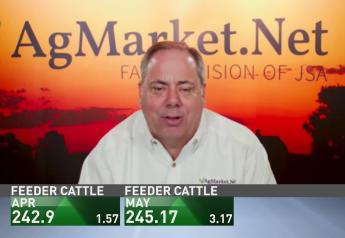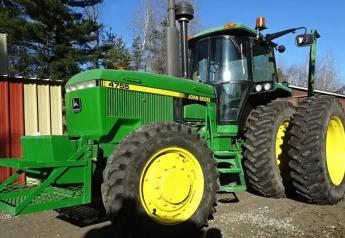Bizarre Mystery of Mummified Coon Dog Solved after 40 years?
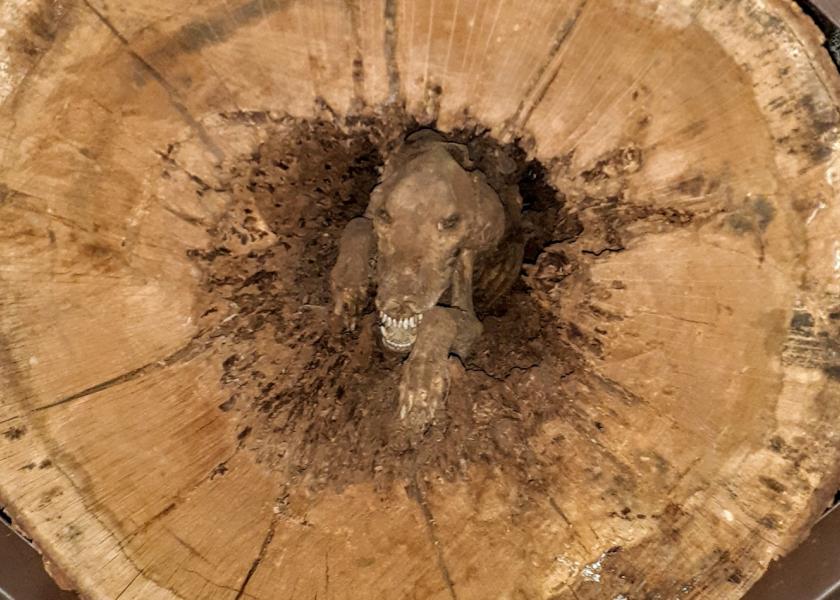
Trapped inside a hollow tree trunk, nature’s cruelest coffin, a hunting dog manically clawed for a sliver of space and desperately fought for life. The greater the hound’s effort; the greater the tree’s grip. Wedged in a wooden vise, the dog spent its last breaths within the heights of the trunk, final whimpers unheeded, and died as a permanent part of the oak—mummified in motion.
Lost in the canopy, almost 30’ above the floor of heavy northeast Alabama woods, the hound remained lodged in the trunk for roughly twenty years, hidden from the searching eyes of a forlorn master, but also shielded from predators, insects, and the elements. In 1980, a logging crew entered the hilly ground, toppled the oak, and chanced upon the stunningly well-preserved canine. Macabre to some, poignant to others, and fascinating to all, the story of the coon dog’s demise, discovery, display—and possible origin—is too bizarre for fiction.
Closing the Coffin
Tucked in the southeast corner of Georgia, at the edge of 438,000 acres of Okefenokee Swamp—Waycross serves as the seat of Ware County, as well as the home of a unique museum and a most curious resident—a dog that draws attention from all quarters of the globe.
The museum, Southern Forest World, opened its doors in 1981. “You name it, they come from states all over America,” says Bertha Dixon, owner and director. “England or Europe or Japan—people come all the way here for a look at Stuckie.” (Stuckie, indeed. In 2002, Southern Forest World opened the dog’s naming rights to the public, and “Stuckie” garnered the most votes as the winning moniker.)
Southern Forest World’s main building, a rotunda structure lined inside and out with Georgia pine, features a chestnut oak log as an unofficial showcase. The 7’ log, resting vertically above the floor with swinging glass protection plates attached to both end openings, contains the preserved body of the bluntly named hound, Stuckie, and draws a visceral response from most visitors. With no taxidermy, limb manipulation, staging, or ornamentation of any kind, he is frozen in situ at the log’s lip, as if in the strained process of emergence—claw and teeth exposure enhanced by approximately 60 years of dehydration.
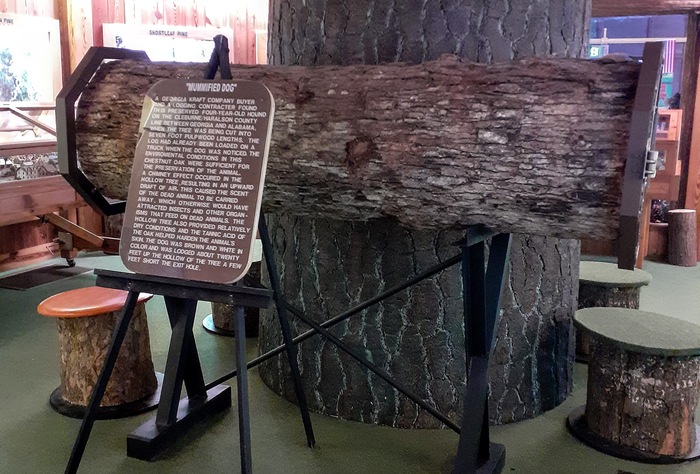
Viewed from the log’s front end, Stuckie’s legs, head and front shoulders are visible, along with a small bit of leather strap on his upper back, probably the remains of a collar. Viewed from the rear, through the log’s reverse opening, hind quarters and tail are visible. The log’s ample diameter of 2’ is misleading—the hollowed cavity is only a handful of inches wide, a death tube for a full-size hound.
Dixon, well-versed in all manner of silviculture and forest oddities, easily recalls her first encounter. “I was amazed by him. Realizing what I know about forestry and trees, I understood how unique the circumstances had to be for Stuckie to be preserved. He is a hound breed and appears to be some shade of brown with some white coloring, and died at around four years old, chasing a coon up a chestnut oak.”
At some point in the 1960s, entering via a hole at the chestnut oak’s bottom, Stuckie scrambled up and inside the trunk that grew increasingly tight with height, Dixon explains. Translated, the tree’s wide and welcoming bottom hole slimmed to a narrow exit, providing an ideal escape hatch for a raccoon, but a tomb for a dog. Once Stuckie was trapped in place, the oak operated as a preservation chamber: “It’s the tannins,” Dixon explains. “A chestnut oak has acid, tannins, that actually soaked into the dog to preserve him. On top of that, his scent of decay went out the top of the tree in a chimney effect as the air went bottom to top. Anything that normally would have consumed the dead flesh, like a predator or insect, couldn’t smell him or get to him.”
“I always wondered about the backstory on what had happened,” Dixon continues, “and then one day a man walked in the door of our museum and told me: ‘I’m the one that cut down the tree. I’m the one that found the dog.”
Saws and Claws
In 2017, Dixon pulled back the curtain on the highly improbable canine discovery. “This man came in from Alabama and he was a logger on the original crew that cut the chestnut oak, and I was in shock,” she says. “In fact, I was so overwhelmed with information I never got the man’s name, but I sure remember his story.”
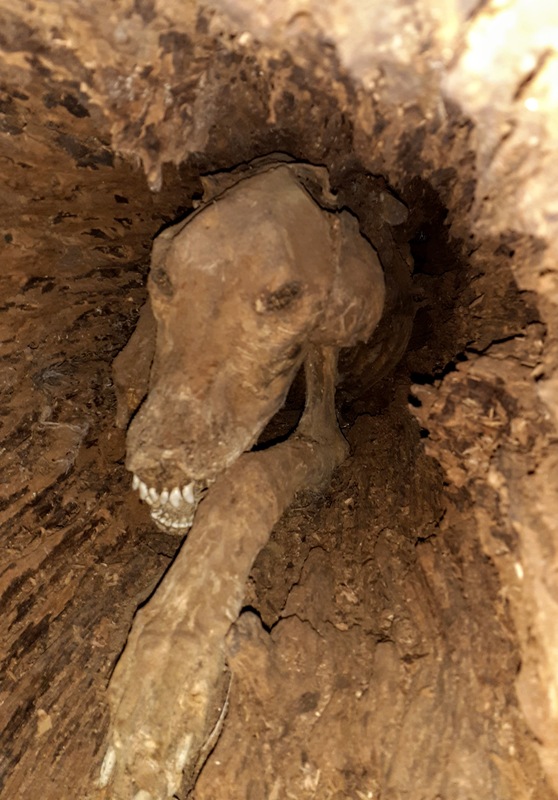
In 1980, according to the information provided to Dixon by the visitor (John Doe), a logging crew out of Rome, Ga., (Kraft Co.) was harvesting trees for pulpwood along the upper Alabama-Georgia border, in Cleburne and Haralson counties. On the Alabama side of the line (Cleburne County), the loggers began cutting hardwoods on hilly terrain in a relatively remote area—with no communities nearby, excluding four isolated houses in proximity.
The chestnut oak was cut into eight 7’ lengths. “Back in 1980, Georgia loggers didn’t transport trees in full length. They cut trees in 7’ sections.” Dixon explains. “Stuckie was in that tree and even though his preservation by nature is incredible, his preservation from logging damage is also incredible.”
Stuckie was waiting in the top of the section from the fourth cut—an approximate height of 28’. “First, when the tree was sawed down and fell, he wasn’t damaged at all. Second, it’s unbelievable that the saw completely missed him and didn’t turn him to sawdust when the tree was cut into sections. Third, when they put him on the truck, he again wasn’t damaged. When you understand the power and force involved in the falling, cutting, and transporting of logs, the fact that Stuckie never moved is unreal. The fact that he didn’t end up as pulpwood beats all the odds.”
“There is only a tiny space between the cut at the end of the log and where his paws are at,” Dixon continues. “No doubt, once you include the stump and count up, he was 28’ up the tree. Amazing.”
However, John Doe and the logging team were unaware of the canine passenger inside the fourth cut of the chestnut oak. Several logs at a time, the crew filled a trailer, periodically pausing to ensure the load was secure.
“One more time, he was going to make sure the trailer was loaded right. He walked around behind the logs, got up close—and saw claws. He backed way, way up, and told me, ‘Oh my Lord, what is coming out of this tree for me?’ In that moment, he had no idea what it was, and he didn’t even know if it was dead or alive. Somehow, someway, Stuckie avoided being turned to pulpwood.”
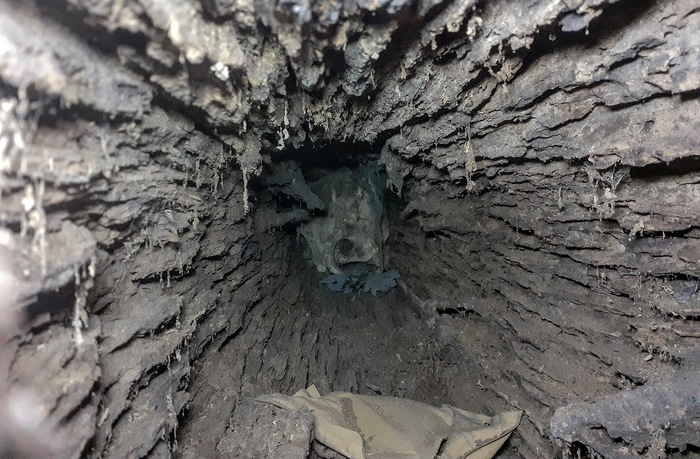
John Doe provided the puzzle pieces related to discovery, but what of Stuckie’s origin?
Enter Roger Prater, renowned coon hunter. “I know where that dog came from; I know what breed it was; and I know who lost him.”
Lost Redbone?
A coon hunter since childhood, Prater, 71, lives in Concord, Ga., roughly 50 miles south of Atlanta, but was raised in Haralson County, 20 miles from the chestnut oak that held Stuckie. Prater is a lifelong devotee of coon hunting and his true passion is a love of dogs. “My dogs are my family. God had a genuine purpose when he made dogs, and you won’t ever, ever find a more wonderful animal.”
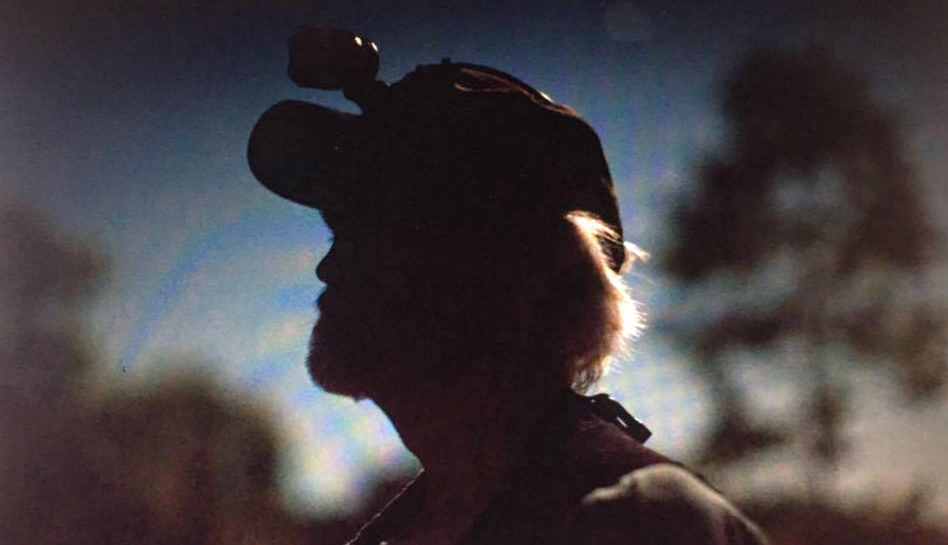
Alongside a 40-year career spent in construction, Prater owns 600 acres of Pike County land he once worked between crops, cattle, and hay. Today, he rents out the 600 acres, and the self-titled “shade tree” farmer is a true authority on treeing walker coonhounds. His breeding business is championed by hunters across the United States: “I used to hunt redbone hounds in the 1960s and 1970s, but now I’ve had the same treeing walkers for 40 years from the Finley River strain and my dogs are hunted in about 30 states, mainly coons, but also bobcat, bear, and mountain lion.”
In 1980, Stuckie’s discovery put to rest a family hunting mystery, Prater says. “At the time, that whole area where he was found was heavy coon hunting because it was a huge section of woody hills, and there wasn’t much there except bootleggers and pulp-wooders. I was sitting in the barbershop and heard about this dog that was as old as Methuselah found by some loggers, and then the story was in the Haralson County newspaper, and then somebody hauled the dog and log to the county courthouse, before it went to the museum.”
Hunters by the dozen declared ownership of Stuckie, according to Prater. “Everybody around claimed the dog, but I knew the likely truth. That dog belonged to my cousin Keith Robinson.”
During a hunt in the early 1960s, Robinson (now deceased) lost a redbone hound in the precise vicinity of the chestnut oak, according to Prater. “Keith spent weeks and weeks in those woods, looking so hard for that redbone, and never found his dog. No trace and no clue—until the loggers showed up.”

At first comparison, a redbone hound, classically chestnut in color, doesn’t match the description of a brown and white hound. However, a redbone hound can have patches of white on the chest, and sometimes white coloration on the paws. Prater believes the dogs are one and the same: “That dog was Keith’s redbone. I believe that with my heart and mind.”
“His redbone was a treeing fanatic—fanatic like you ain’t never seen, and that is one of the most important keys to figuring out who the dog is,” Prater adds. “There’s a whole lot more going on than just a dog stuck in a tree, and hunters know what I’m talking about. If you truly want to understand the dog inside the tree, then you have to realize what was happening on that hunt. You’ve got to understand coon hunting.”
Slobbermouths Rule
“I've never left my dogs in the woods, and I'm not going to now, even if I have to look for them myself,” –12-year-old protagonist Billy Colman, speaking in ‘Where the Red Fern Grows,’ Wilson Rawls’ benchmark 1961 novel centered on a young hunter’s bond with a pair of redbone coonhounds.
Despite an individual’s prowess or outdoor skill, coon hunting relies squarely on the ability and training of phenomenally intelligent and durable dogs. Chasing a telltale, bawling symphony of hounds in the dead of night, on the trail of a masked bandit through tangled gullies, sloughs, and wooly cutovers is arguably the most evocative chase in all of hunting, and when executed by top dogs, it is a timeless display of instinct and primal bloodlust.
Typically, hunters release coon hounds and wait for the dogs to strike a coon (a predominantly nocturnal animal) scent. In the 1960s, decades before GPS and digital tracking technology, hunters watched the hounds disappear into the woods in a general direction, but were blind to true individual or pack location until a coon scent was struck.
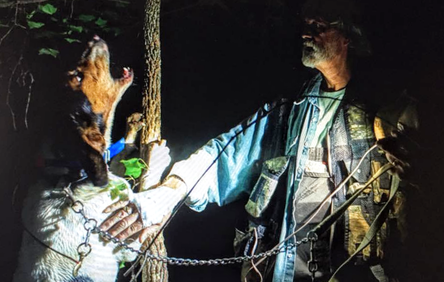
When a hound crosses a hot scent (sometimes cold), it cuts loose with a deep, guttural bawl—laced with a beautiful musical quality unique in nature. The coon scent is captured, dogs give chase, long bawls resound, hunters scramble after the sounds, and the hunt is on.
Bawl. Bawl. Bawl. The physical distance between master, dogs, and coon is always variable, and is heavily contingent or terrain and weather, ensuring a hunt may require mere minutes or extend to several hours. Time is controlled by the speed of the dogs, distance upon strike to the coon, how far the coon chooses to run, and a seemingly endless host of additional factors.
Consistently bawling on the track of the coon, the dogs close the distance and when the pressure eventually gets too hot, the coon goes up—into the relative safety of a tree. When the coon takes to a tree and a hound arrives in the vicinity, the sound of the long bawl often switches to a changeover—a distinct inflection declaring an end to the coon’s ground movement. In rapid succession, the hound sniffs out the tree sheltering the coon, and when certain, makes an absolute commitment—“fell treed”—by placing it’s front paws on the trunk, raring back, and opening up with a staccato series of chop barks. The chops are manically incessant, distinguishing some hounds as “slobbermouths,” capable of rattling off 80 to 100 chops per minute.
The hound, nearing the climax of a hunt, is in a primal zone, zeroed on the coon prey. The catch-at-all-costs mode of some hounds is the full explanation of how and why Stuckie was trapped in the chestnut oak, Prater emphasizes. “Some dogs lose their minds when they get close to a coon. That’s what happened when he saw that hole at the bottom of the tree and went in. At that exact moment, that wasn’t a normal dog; that was a dog with everything except the coon locked out of its brain.”
“I’ve seen dogs do unbelievable things when chasing a coon,” Prater continues. “Dogs fall through ice or I’ve seen dogs chase coons underground into holes and smother. I’ve watched dogs climb up into trees through the limbs like a cat, keep going up after a coon, and then fall out and die. In the wrong circumstances, they will get crazy and nothing will stop them getting to the coon. Nothing.”
Into the hole and up the oak trunk, Stuckie put his back on one side of the hollow, paws and claws against the other, and pushed toward the coon, which merely ascended further up the wooden tube, ensuring pursuit—and death of a hound.
“There was no way to track the dog back then,” Prater adds. “How could Keith have known where his dog was? Most of the time back then nobody had a tag on their dogs, and sometimes not even a collar.”

Dogs on a hunt always know where the master is waiting, or at least the locale where they were released to begin the hunt. And significantly, particularly in the 1960s, an owner had no reliable means to know where the dogs might be roaming, other than the audible cacophony of the moving pack. No dog sounds; no clue on location. For decades, and likely for centuries, when hunting dogs got lost, owners left behind a coat or article of clothing at the point of release, in hopes the missing dog would return to the spot. On many, many occasions, the time-honored technique worked to perfection, with a hunter returning the following day to find a lost hound resting on a coat.
“When a dog gets away in coon hunting, it can be miles and miles,” Prater says. “Sometimes they just go and go until they find the game and tree. Even if you were only a half mile away in those hills, they were out of hearing fast. Keith laid down his jacket that night, but the dog never came back. It couldn’t get back to him. It couldn’t get back home.”
Rest in Peace
At Southern Forest World, Stuckie is the resident of honor, and his drawn and withered appearance evokes a steady chain of response. “Some adults are a little scared at first, but when most people see Stuckie, they feel sad about what happened and want to know more,” Dixon says. “One thing for sure, we’ll always take care of him here. People will be talking about Stuckie long after we’re all gone. No matter how you see what happened, he’s a very, very special dog.”
R.I.P. Stuckie—the coon dog that refused to quit.
“The dog lives for the day, the hour, even the moment.”—Robert Falcon Scott, 1911
For questions or to read more stories from Chris Bennett (cbennett@farmjournal.com), see:
While America Slept, China Stole the Farm
Where's the Beef: Con Artist Turns Texas Cattle Industry Into $100M Playground
The Arrowhead whisperer: Stunning Indian Artifact Collection Found on Farmland
Fleecing the Farm: How a Fake Crop Fueled a Bizarre $25 Million Ag Scam
Truth, Lies, and Wild Pigs: Missouri Hunter Prosecuted on Presumption of Guilt?
US Farming Loses the King of Combines
Ghost in the House: A Forgotten American Farming Tragedy
Rat Hunting with the Dogs of War, Farming's Greatest Show on Legs
Misfit Tractors a Money Saver for Arkansas Farmer
Predator Tractor Unleashed on Farmland by Ag's True Maverick
Government Cameras Hidden on Private Property? Welcome to Open Fields
Farmland Detective Finds Youngest Civil War Soldier’s Grave?
Descent Into Hell: Farmer Escapes Corn Tomb Death
Evil Grain: The Wild Tale of History’s Biggest Crop Insurance Scam
Grizzly Hell: USDA Worker Survives Epic Bear Attack
A Skeptical Farmer's Monster Message on Profitability
Farmer Refuses to Roll, Rips Lid Off IRS Behavior
Killing Hogzilla: Hunting a Monster Wild Pig
Shattered Taboo: Death of a Farm and Resurrection of a Farmer
Frozen Dinosaur: Farmer Finds Huge Alligator Snapping Turtle Under Ice
Breaking Bad: Chasing the Wildest Con Artist in Farming History
In the Blood: Hunting Deer Antlers with a Legendary Shed Whisperer
Corn Maverick: Cracking the Mystery of 60-Inch Rows


